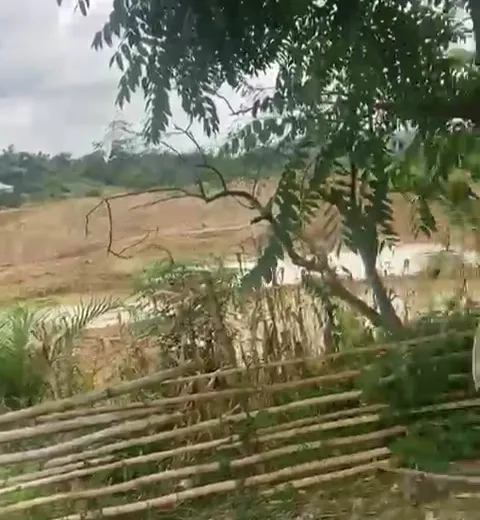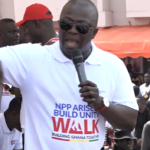Residents of Asuoho Konkoma, a small farming community in the Bosomtwe District of the Ashanti Region say they are living in fear as illegal mining activities, locally known as galamsey — threaten to destroy their only basic school and health centre.
A footage obtained by Asaase News show how illegal miners have taken over large portions of land reserved for public facilities, digging deep pits dangerously close to the buildings and putting the safety of pupils, teachers, and health workers at risk.
https://www.facebook.com/reel/1552613786164470
“The miners are now operating right on the school premises,” one resident said. “They’ve dug near the classrooms, and if this continues, the structure will soon collapse.”
Our community is now under attack. We fear for our children anytime they go to school. It is sad that nobody has come to flush out these people from here”, another indicated.
Under siege
The Asuoho Konkoma Health Centre, which serves several nearby villages, is also at risk. Residents said miners are now working just metres away from the facility, raising concerns about contamination, noise, and the weakening of the building’s foundation.
Locals say their complaints to district authorities and the police have gone unanswered, leaving them frustrated and helpless as the miners continue to operate openly.
They have appealed to the Ashanti Regional Security Council to deploy security forces to halt the activities before a disaster occurs.
“The same thing is happening at the health centre,” another resident explained. “If security authorities don’t act fast, we will soon lose our only clinic.”
“We are on the brink of losing both the school and the hospital,” one community leader warned. “We can’t sit and watch while our children’s future and our only healthcare facility are destroyed.”
Abuse of power?
Commenting on the illegal mining in the area another source blamed politicians and said not enough has been done flush them out.
“And the situation has intensified since this power changed hands. Our rivers and lands are being destroyed and no political head or traditional leader is talking about this. It appears they are also complicit.
“Truly, I can’t just come from home and enter then start mining without someone shielding me. And [their bosses] are the people they literally work for … They are shielded by them [politicians],” the source stated.
No official was available for comment.
Speaking on Kumasi-based Luv FM Convenor of the Media Coalition Against Galamsey, Dr Kenneth Ashigbey, condemned District Chief Executives (DCEs) for failing to effectively carry out their mandate to curb illegal mining.
He stressed that the fight against galamsey would continue to be undermined unless DCEs are held accountable for what happens in their jurisdictions.
“Anywhere that we’re seeing galamsey happening, there’s a DCE in that community,” he said. “The President has given them a KPI to fight galamsey. So if galamsey is still happening, then it means you have failed.”
Dr Ashigbey argued that public officials should face consequences for underperformance, just as workers in other sectors are sanctioned when they fail to meet key performance indicators.
“If you fail to meet your KPIs in any other job, you’ll be interdicted and investigated,” he said. “But in these political appointments, the President can immediately dismiss or investigate a DCE for complicity. It cannot be that from Tarkwa to Takoradi, when you pass through Simpa and see pits near the water bodies, the MCE says he doesn’t know about it.”
Dr Ashigbey described galamsey as part of a wider, organised crime network that extends far beyond those physically engaged in mining activities.
‘Part of our DNA’
A global surge in prices is driving what Martin Ayisi described as “a gold rush” in Ghana, the world’s sixth-largest gold producer. “Gold is everything to us, it’s “part of our DNA,” said Martin Ayisi, a former head of the Minerals Commission, a government body that regulates its mineral wealth, excitedly told CNN. “Our whole life is tied to gold.”
“Prices have gone through the roof,” he explained from his spacious office in Accra, alluding to the increase in value by roughly 30% so far this year.
Approximately 36% of the gold exported in the first half of 2024 was sourced from regulated small-scale mines. The rest, according to the Ministry of Lands and Natural Resources, came from large-scale mining operations.
Officials say that the bulk of Ghana’s exported gold was sold to the United Arab Emirates and India.
The Minerals Commission makes a distinction between unregulated, small-scale mining – galamsey – and legal artisanal mining. There is little data about the former, though its impact can be seen across the rural landscape.
However, in September, the media quoted Chris Aston, the head of a new bilateral gold program between the UK and Ghana, as saying that “Ghana loses more than $2 billion yearly to gold smuggling.”
In 2021 galamsey accounted for “an estimated 60% of Ghana’s mining labor force”.
Though miners make the least in the gold supply chain, illegal mining provides much needed employment. More than a million people, aged below 35, are without jobs, according to Ghana’s Statistical Service.
Rife youth unemployment and the high prices of gold are driving more people into the industry.
The number of small-scale gold mining licenses or permits issued by Ghanaian authorities leapt from 12 in 2019 to almost 650 in 2020, according to data from the Minerals Commission.
Source: asaaseradio.com




